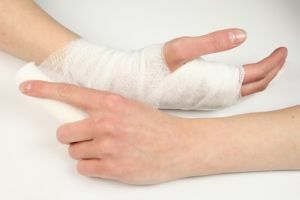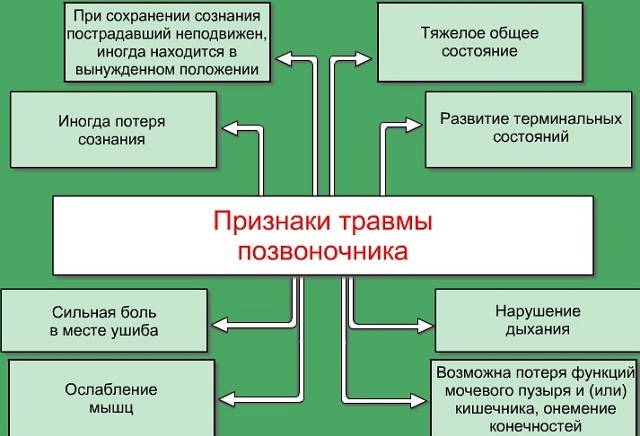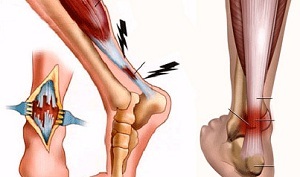 Stretching of the ligaments of the foot is damage to the tissues in the corresponding area of the foot, which is usually seen from the outside.
Stretching of the ligaments of the foot is damage to the tissues in the corresponding area of the foot, which is usually seen from the outside.
Very often this is due to the weakening of the ligaments due to a sedentary lifestyle. Also, similar problems often occur in athletes, but already because of the excessive load on the ligaments.
However, "stretching" is not quite the right term for this violation.
The bundles themselves consist of two types of fibers:
- elastic( corresponding in fact for elasticity);
- collagen( providing strength of the ligaments).
It should be noted that the ligaments are not really so elastic that it was just "stretching", even at very high loads. In fact, in this situation, there is a rupture of the ligaments of the foot.
Thus, the degree of severity of damage is determined by the number of injured tendons and fibers. With this type of injury, the muscles always remain intact.
Contents of the article
- Anatomy of the foot and ankle
- Causes of injuries
- Detecting is not difficult
- First aid
- Therapy of injury
- Treatment with folk remedies
- Rehabilitation and preventive measures
Anatomy of the foot and ankle
The foot is part of the musculoskeletal system of the human body. Its structure is quite simple - it consists of bones, ligaments and muscles:
- Bones of are the basis, the skeleton.
- The ligaments perform a connective function. They fix and hold the bones in a certain position, forming the joint itself, and to a certain extent create restrictions in motion.
- Muscles attach to different bones and girdle them. Those of them that are attached to the foot, start much higher - in the region of the shin.
Ankle joint consists of bones of lower leg and talus and has a block-shaped shape.
By itself, it is formed by three groups of ligaments: anterior and posterior talus-fibular and heelico-fibular ligaments:
- The first group of includes inner ligaments that connect the small and large tibia.
- The second group is formed by a deltoid ligament, namely its internal and external surface.
- To the third group of belong calcaneus and talon-fibular ligaments located on the external side of the ankle. The last group of ligaments is most vulnerable and is prone to injury.

Causes of injuries
The main cause of stretch of the ligament of the foot is, first of all, its anatomical structure.
The ankle joint system is small, but it takes quite a serious load.
Bundles in this case are very important, because they not only restrict the bones, but also provide a free( to a certain extent) movement in different directions.
In addition, when performing the function of joint restriction, they protect it from various injuries, however, if the load exceeds that which they are able to withstand, the deformation of the joint results - stretching or, in the worst case, breaking.
As already mentioned, the main causes of stretching are excessive loads.
In addition, the reasons may be:
- is overweight;
- is too active;Awkward shoes;
- wearing weights;
- bruises about various objects;
- congenital factors;
- as well as some infectious diseases and metabolic disorders.
Identifying is not difficult
The most common symptom in stretching the ligament of the foot is pain in its outer part. In this case, the damaged area can become slightly swollen, a hematoma appears.
As a result, the walking process is difficult because the person can not fully rest on his leg due to pain.
Three degrees of tension are distinguished, which are determined by the number of broken fibers and tendons, as well as the degree of general joint damage:
- The first degree is characterized by a slight rupture of some fibers. This stretching is accompanied by moderate pain, perhaps a slight swelling or lameness. In general, the foot remains fully functional and fully functional.
- The second degree of stretching is a more significant fiber rupture, although the bundles themselves also remain intact. It becomes difficult to walk, there are enough severe pain, there are hematomas.
- In the third stage of , the integrity of one or more ligaments is impaired. Such injuries are most often accompanied by fractures, in particular fractures of the foot and ankle. There is a lot of pain, swelling, blood accumulates in the joint. Completely lost the ability to move independently. In addition, the foot does not seem to hold in the joint - it becomes too mobile until uncontrollable.
Since the disruption of the ligament of the foot can be considered a stretching of the third degree, it is quite easy to distinguish.
However, for the full reliability of the diagnosis should definitely consult with a doctor and make an X-ray. An easy stretch can be diagnosed by external signs - swelling, blueness of the damaged area, painful sensations.
First aid
First aid for stretching the ligaments of the foot should be provided in the shortest possible time.
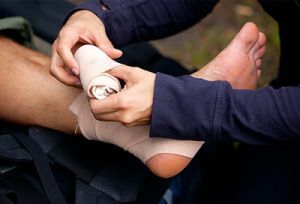 First of all, you need to take off your shoes and release your leg. Otherwise, the leg will swell, and access to the sore spot will be blocked.
First of all, you need to take off your shoes and release your leg. Otherwise, the leg will swell, and access to the sore spot will be blocked.
Next, fix the foot in a position at right angles to the shin and apply a tight bandage. The tight bandage function is to ensure that the foot can not move.
To stop inflammation and minimize pain, you need to apply something cold. As soon as the first medical aid to the victim is rendered, it is necessary to deliver it as soon as possible to the doctor.
Injury therapy
Qualified treatment depends on the severity of the injury. Serious cases require surgery. If the stretching is insignificant, it is enough to dispense with therapeutic methods.
The most common means of treating such injuries is ointment or gel.
These drugs contain anti-inflammatory, cooling and anesthetic substances( menthol, diclofenac, indomethacin).
It is possible to prescribe non-steroid drugs in various forms( tablets, injections).Further, physiotherapy and exercise therapy are used to restore the mobility of the joint.
Treatment of folk remedies
Among the traditional methods of treatment, the most common and effective is the water sponge, which is diluted with water before the formation of gruel, and applied to the site of injury.
The essence of this substance lies in its ability to draw blood and other fluid onto itself, thus removing the hematomas and swelling. A similar in effect and strength effect is also cabbage and raw potatoes.
A good anti-inflammatory property is a raw onion combined with salt. The onion is ground to a mushy mass, a spoonful of salt is added and, wrapped in a cloth, is applied to a sore spot.
Rehabilitation and preventive measures
Depending on the complexity of the violation, the rehabilitation period may vary - from a week to a year and a half, .In the first time 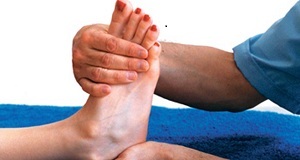 should not be heavily loaded leg, it is recommended to observe peace.
should not be heavily loaded leg, it is recommended to observe peace.
In addition, it is recommended to wear a tight bandage for a while to fix the joint. Also shown is a special therapeutic exercise that restores mobility.
Timely contact with a doctor and taking the necessary measures at home minimizes or nullifies any consequences.
Otherwise, surgery may be necessary.
The simplest thing that is required as preventive methods is to exercise to strengthen the musculoskeletal system in general and, in particular, the ankle joint.
Do not overload your legs with excessive activity or weight. It is also not recommended to wear shoes with high heels too often, so as not to provoke damage once again.
During sports, you need to ensure that the shoes are comfortable( not wide and narrow and, naturally, in size) and supports the lifting of the foot. 
Despite the fact that stretching of the ligaments is not too serious injury( in the case of 1 and 2 degrees of severity), it is worth to carefully treat this joint, because it is one of the main supports of the human body.
Even if the damage does not limit mobility, it can create undesirable inconveniences. And it is obligatory, in case of getting this type of injury, medical measures should be taken immediately to avoid undesirable consequences.

